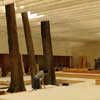Venice Architecture Biennale 2012, Architects, Exhibitions, Italy, Pavilions, News
Venice Biennale 2012 : Architecture
Architectural Show in Italy: la biennale di venezia – buildings + architects
26 Aug 2010
Venice Biennale Architecture 2012 News
Venice Biennale Architecture 2012 – key architectural designs:
Venice Biennale European Pavilion, Italy – news
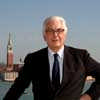
photo : Giorgio Zucchiatti, Courtesy La Biennale di Venezia
President Paolo Baratta, Architect Winy Maas, launched the EU CITY Manifesto with a large audience at the preview days of Venice Biennale Architecture 2012, « Through architecture we show what kind of democracy we can build. What kind of Europe do we want? » asked President Baratta in his opening remarks at the EU City Manifesto Conference in Venice on the 27th of August 2012. « The possibility of a splintered Europe comes again into perspective. How to react to that? How to visualise this and to give optimistic visions? » answered architect Winy Maas (MVRDV, T?F).
Wolf Prix Critique of the Venice Biennale
‘Hollow, Bleak and Boring’
Article for e-architect by Roland Wahlroos-Ritter – 5 Sep 2012

photo : Neale Smith Photography
Wolf Prix with his prickly critique of the Venice Biennale, initiated and published by Bkult.de, is setting the tone for this week’s projects review.
Wolf D. Prix, COOP HIMMELB(L)AU, Austria
Attacks Venice Biennale of Architecture 2012

photo © Elfie Semotan
“If one did not know that the media constantly exaggerates, one could almost conclude – as the Süddeutsche Zeitung has – that the Venice Biennale of Architecture really is the world’s most important architecture exhibition.
However, I believe that the word “exhibition” is not intended to describe an exhibition in this case, rather that the notion only designates the event per se. In other words an industry meeting, like a product fair. Other critics fail to even question the purpose of the exhibition, rather they immediately conclude that the coming together, the meeting, the networking is the key aspect. That’s that!”
Zaha Hadid Exhibitions – ‘Arum Installation’
Venice Architecture Biennale 2012, Italy
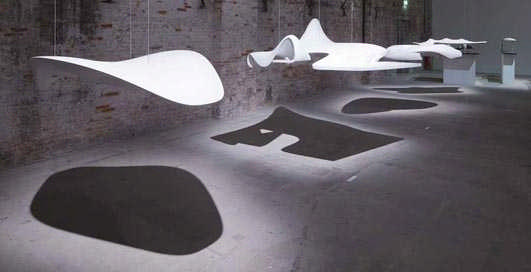
photograph courtesy of Iwan Baan
This year’s Biennale theme ‘Common Ground’ shows how the work of the major protagonists of contemporary architecture – often regarded as independent individual creations – is in fact based on historical lineages of collective research. This is also true of the work of Zaha Hadid Architects. It is well known that the early work was initially inspired by Russian Suprematism.
Venice Architecture Biennale 2012 Room 1.9, Corderie dell’ Arsenale
biq stadsontwerp – news
Rotterdam architects participate in Architecture Biennale in Venice, Italy
Contribution with social housing project to David Chipperfield’s motto ‘Common Ground’
Rotterdam, 28th of August 2012 – ‘Common Ground’ is the topic of the 13th International Architecture Exhibiton, directed by David Chipperfield and organized by la Biennale di Venezia. Invitations went to a list of contributors who invited additional architects to join their attendance. biq stadsontwerp is part of the group gathered by London architects Peter St. John and Adam Caruso.
Venice Architecture Biennale 2012 News
Kazuyo Sejima Named as First Rolex Architecture Mentor
Rolex mentoring programme extended to architecture
Kazuyo Sejima in Venice
Direttore della 12. Mostra Internazionale di Architettura – La Biennale di Venezia
Director of the 12th International Architecture Exhibition – La Biennale di Venezia
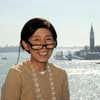
photo : Giorgio Zucchiatti, Courtesy La Biennale di Venezia
Venice, 28 August, 2012 – Japanese architect Kazuyo Sejima has been named as the first architecture mentor in the Rolex Mentor and Protégé Arts Initiative, it was announced today at the 13th International Architecture Exhibition – la Biennale di Venezia.
Architecture will now be added as a seventh category in Rolex’s global philanthropy programme, which includes literature, music, visual arts, dance, film and theatre.
Kazuyo Sejima, photo as the Director of 12th International Architecture Exhibition in Venice

photo © Adrian Welch
Sejima, a partner in the architecture practice SANAA, joins a distinguished line-up of Rolex mentors for the current cycle of the programme, which pairs major artists with rising young talents. They are: Margaret Atwood (literature), Patrice Chéreau (theatre), Gilberto Gil (music), William Kentridge (visual arts), Lin Hwai-min (dance) and Walter Murch (film).
Sejima’s protégé will be named in autumn 2012. The young architect will be invited to spend time over a period of a year working on Home For All. The project was created by Sejima and other leading Japanese architects – Toyo Ito, Riken Yamamoto, Hiroshi Naito and Kengo Kuma – to respond to the housing crisis following the devastation caused by the 2011 tsunami in Japan.
Sejima and her partner Ryue Nishizawa won the Golden Lion at the 2004 Venice Architecture Biennale for the 21st Century Museum of Contemporary Art in Kanazawa, Japan. In 2010, they won architecture’s highest accolade, the Pritzker Prize, and that year Sejima became the first woman appointed as director of the architecture sector of the Venice Biennale. Among her major works is the 2010 Rolex Learning Center for the Ecole Polytechnique Fédérale de Lausanne (EPFL), an architectural landmark in Switzerland, of which Rolex was the lead private funding partner.
The Rolex Mentor and Protégé Arts Initiative was founded in 2002 to encourage and develop talented individuals through a unique programme of one-to-one mentoring with a major figure in each field of the arts. For the first cycle of the programme in 2002, the visual arts mentor was Álvaro Siza, who selected the young Jordanian architect, Sahel Al-Hiyari, as his protégé.
Over the past 10 years, the creative community has expanded, ranging across continents and cultures, and now includes more than 80 major creative artists of different generations and backgrounds.
For the first time, Rolex is a sponsor of the Architecture Biennale – and is providing special support for a project commissioned by Sir David Chipperfield between Álvaro Siza and his long-standing collaborator, Eduardo Souto de Moura. Siza will receive the Golden Lion Award for Life Achievement at Venice this year.
Rebecca Irvin, head of Philanthropy at Rolex, said today: “We are delighted to announce Kazuyo Sejima as the new architecture mentor in Venice, and to be able to support the 13th International Architecture Exhibition as the leading focus of international architectural debate and ideas. We are also delighted to be associated with Álvaro Siza who was the first mentor in the visual arts for Rolex.”
28 Aug 2012
Venice Architecture Biennale – Common Ground
Foster + Partners – Venice Architecture Biennale : Common Ground
Norman Foster has curated two spaces for the 2012 Venice Architecture Biennale: the ‘Gateway’ installation at the head of the Arsenale, which is the first gallery that visitors pass through within the Corderie. The second space is in the Central Pavilion in the Giardini.
Norman Foster has chosen to interpret the theme of Common Ground in two ways. First in words, as the body of knowledge represented by the names of generations of architects, critics, designers, landscape architects and planners, who from antiquity to today have influenced the urban world. Secondly though images, which show the communal gathering spaces that bring us all together socially, outside or inside buildings.
Venice Biennale British Pavilion, Italy
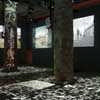
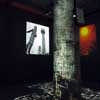
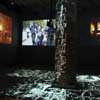
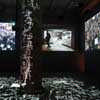
images © Carlos Carcas
For the ‘Gateway’ installation in the Arsenale, Norman Foster brings these two interpretations of the theme together in the words and images which he selected to create a black box experience. Visitors enter via symmetrical ramps into an immersive space, in which the floor and audience are washed by projected words, white on black and constantly in motion. On the walls of the space, projections of huge, rapidly changing images flash above the heads of the audience in an installation by filmmaker Carlos Carcas.
They range from the historic spaces of the western world, to the booming new cities of Asia and South America, as well as the favelas, which are an inseparable part of these emerging urbanities. In the spirit of Common Ground, these thousands of images have been solicited from a global network of architects, planners, photographers, critics, writers and artists. The fusion of names and images are accompanied by a background soundtrack specifically composed for the installation.
The installation has been made possible by the Norman Foster Foundation and Ivorypress.
In the Central Pavilion in the Giardini, an exhibition focuses on the plaza below the Hongkong and Shanghai Bank tower as a gathering space. There were several early design variations for the Bank, which culminated in the final scheme, completed in 1985. The common denominator from the outset was a civic space created by lifting the building up to ensure a flow of pedestrian movement across the site.
Through models, sketches, drawings and photographs, the exhibition shows the evolution of the design of this public space and the tower that defines it, culminating in a photograph of the building by the artist Andreas Gursky. On Sundays, this space is transformed into an outpost of the Philippines, as hundreds of maids establish a community, with an extraordinary variety of social activities and intimate spaces created by cardboard walls. This aspect of the Bank is also explored in the work of artist Marisa Gonzalez. The triptych painting of the banking hall by Ben Johnson complements the view of the plaza from above by the photographer John Nye.
In the Hong Kong Pavilion in the Arsenale, Foster + Partners’ design for the Kai Tak Cruise Terminal, part of the redevelopment of the former airport site, has been selected and curated by Chris Law. Continuing the theme of Common Ground, the terminal features a large public roof garden, set against the stunning backdrop of the city.
31 Dec 2011
Venice Biennale Director
David Chipperfield to direct Venice Biennale
As we reported on 10 Nov 2011 the Board of the Venice Biennale chaired by Paolo Baratta appointed David Chipperfield as Director of the upcoming Architecture Biennale. e-architect brings youi further details below:
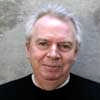
photo of David Chipperfield architect © Martin Godwin
David Chipperfield was named Director of the Architecture Sector with the specific responsibility of curating the 13th International Architecture Exhibition, which will be held in Venice, at the institutional venues of Giardini and Arsenale, from August 29th to November 25th 2012 (preview on August 27th-28th).
For Architecture, the Board of Administration knew that David Chipperfield had already been contacted, and that he had shown great interest in being appointed as Director of the International Architecture Exhibition of the Biennale. We thank him for accepting and for having patiently awaited the official designation.
Kazuyo Sejima’s appointment brought this Exhibition back into the hands of an architect, and Chipperfield’s pursues the same course. After a series of Exhibitions that illustrated the many different ways of approaching the theme of architecture in the contemporary era (sociological, technological, urban), it appeared useful to turn to an architect who demonstrates great interest in architecture as a discipline and raises questions about the elements of which it is composed, about the objectives it pursues, about the constraints that affect it, about the tools that it uses to shape places, spaces, buildings.
The next Architecture Exhibition will be characterized by the emphasis on a series of relationships that connect great architects and younger generations that refer to them. This Exhibition will represent a major opportunity to bring both the general public and the world of architecture up to date. This is also why it has already begun to organize the program involving Universities from all around the world, entitled Biennale Sessions, successfully tested during the last edition of the Exhibition.
David Chipperfield in particular says about his project that: “Participants will be encouraged through a declaration of affinities to make connections with other authors and other works. These dialogues and collaborations may involve a common proposal or a dialogue between projects even as a dialogue of provocation. In this way we wish to demonstrate the existence of a rich culture of architectural practice and research, stimulated by the work of other disciplines but defined by shared enthusiasms and concerns at a time when the singular works of architects are celebrated but the role of the profession and our place within society is continuously challenged.”
David Chipperfield studied at the Kingston School of Art and the Architectural Association in London. After graduating he worked at the practices of Douglas Stephen, Richard Rogers, and Norman Foster. He has taught and lectured worldwide, including as Professor of Architecture at the Staatliche Akademie der BildendenKuenste, Stuttgart from 1995 to 2001; and as visiting professor at schools of architecture in Austria, Italy, Switzerland, the United Kingdom and the United States. David Chipperfield is currently Norman R. Foster Visiting Professor of Architectural Design at Yale University.
David Chipperfield Architects was established in 1984 and currently has more than 250 staff at its offices in London, Berlin, Milan and Shanghai. Amongthe practice’s major recent works are the renewed Neues Museum in Berlin; the Anchorage Museum of History and Art, Alaska; the City of Justice in Barcelona; the Des Moines Public Library in Iowa; Ninetree Village, a residential district in Hangzhou, China; the new Museum Folkwang in Essen, Germany; the Kaufhaus Tyrol department store in Innsbruck and the Peek &Cloppenburgflagship store in Vienna; a laboratory building on the Novartis campus in Basel; and in 2011, the Turner Contemporary gallery in Margate and The Hepworth Wakefield, both in the United Kingdom.
Ongoing current projects include a new gallery for the ColecciónJumex in Mexico City; the luxury five star Hotel Café Royal on London’s Regent Street; the Perm Opera and Ballet Theatre in Russia; the Marrakech Gallery in Morocco; Elizabeth House, a major new office and residential development near Waterloo in London; the James Simon Gallery, a new entrance building to Berlin’s Museum Island; a new wing for the Saint Louis Art Museum in the United States; the Ansaldo City of Cultures in Milan; and a new building for the Kunsthaus Zurich in Switzerland.
From the beginning of his career, David Chipperfield has also been interested in the design and function of interior spaces, including shop interiors for Issey Miyake, Joseph, Dolce &Gabbana, and Valentino,as well as a range of furniture, lighting, and tableware.David Chipperfield’s Tonale range of ceramics for Alessi received the Compassod’Oro in 2011, and the Piana folding chair has recently been acquired for the permanent collection at MoMA.
The practice has won numerous international awards and citations for design excellence, including RIBA and AIA awards, the RIBA Stirling Prize in 2007, and the European Union Prize for Contemporary Architecture – Mies van der Rohe Award in 2011. In 1999 David Chipperfield was awarded the Heinrich Tessenow Gold Medal. He was made an Honorary Fellow of the American Institute of Architects and an Honorary Member of the Bund DeutscherArchitekten in 2007 and he was awarded both the Wolf Foundation Prize in the Arts and the Grand DAI Award (VerbandDeutscherArchitekten- und Ingenieurvereine) for Building Culture in 2010. He holds honorary doctorates from Kingston University (2009) and the University of Kent (2010).
In 2004 he was appointed Commander of the Order of the British Empire for services to architecture. He was appointed a Royal Designer for Industry in 2006, and elected to the Royal Academy in 2008. In 2009 David Chipperfield was awarded the Order of Merit of the Federal Republic of Germany – the highest tribute that can be paid to individuals for service to the nation – and in 2010 he was knighted for services to architecture in the UK and Germany. In 2011, he received the RIBA Royal Gold Medal for Architecture; given in recognition of a lifetime’s work, the Royal Gold Medal is approved personally by Her Majesty the Queen.
David Chipperfield : Venice Architecture Biennale 2012 Director
10 Nov 2011
Venice Biennale Curator News
David Chipperfield to curate Venice Biennale
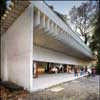
photo : Neale Smith Photography
David Chipperfield is to curate the Venice Architecture Biennale. In 2000, he was one of the architects to represent Britain at the Venice Biennale of Architecture. David Chipperfield also has a connection to the city via his San Michele Cemetery Extension, located on an island between Venice and Murano.
13 Oct 2011
Venice Biennale News
Silvio Berlusconi Replaces Paolo Baratta
Italian Prime Minister Silvio Berlusconi has ousted Paolo Baratta, the President of the Venice Biennale.
On 6 October, Giulio Malgara was named director of the Venice Biennale, by Italian Culture Minister, Giarcarlo Galan. The Venetian is an executive from the food business with no previous connection to the arts, but has a friendship with the Italian Prime Minister.
Paolo Baratta, an architect plus former bank president and politician, has been president of the Venice Biennale since 1998. He has worked to ensure the Biennale is the main arts festival in the world.
Executive Director, Andrea del Mercato, may also leave.
“Why is Malgara considered better?” asked former Venice mayor Massimo Cacciari. “Because he is a friend of Berlusconi’s?”
Previously Silvio Berlusconi has attempted to oust Mario Fortunato, the director of London’s Italian Cultural Institute.
Location: Venice, Italy
Venice Biennale Review from 2010
e-architect editor Adrian Welch visited the Venice Biennale 2010 : photos + observations on the pavilions & exhibitions
Kazuyo Sejima, the Director of 12th International Architecture Exhibition in Venice

photo © Adrian Welch
Photos of the majority of the pavilions in Venice:
Venice Architecture Biennale Arsenale Pavilions
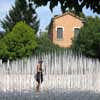
image © Adrian Welch
Venice Architecture Biennale Arsenale Pavilions
Venice Architecture Biennale Giardini Pavilions
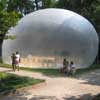
image © Adrian Welch
Venice Architecture Biennale Giardini Pavilions
Bahrain Pavilion, Venice – Golden Lion winner for Best National Pavilion

photo © Adrian Welch
12th International Architecture Exhibition
Venue: Giardini and Arsenale
la biennale di venezia director
Kazuyo Sejima, the Director of 12th International Architecture Exhibition, People meet in architecture (29 Aug – 21 Nov 2010). Kazuyo Sejima was the first woman to direct the Architecture Sector of the Biennale.
SANAA : Kazuyo Sejima (right) and Ryue Nishizawa (left)

picture © 2008 Kazuyo Sejima + Ryue Nishizawa / SANAA
Photograph © Takashi Okamoto
Venice Buildings
Venice Buildings
Venice Biennale Architecture Previous Years
2008 Venice Biennale director: Aaron Betsky, director of the Cincinnati Art Museum
11th International Architecture Exhibition: ‘Out There. Architecture Beyond Building’
Venice Biennale exhibition 2007 : Dune Formations installation, Scuola dei Mercanti

image from architect
Nordic Pavilion, Biennale di Venezia, Italy
1958-62
Sverre Fehn
Venice Biennale shelter architect
Venice Biennale 2004
Excerpts from an Architecture Review of Venice Architecture Biennale by architect Rebecca Wober
“Metamorphoses”
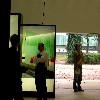
Nordic Pavilion: Venice Biennale
Venice Biennale Arsenale Installation
Comments / photos for the Venice Biennale 2012 page welcome

